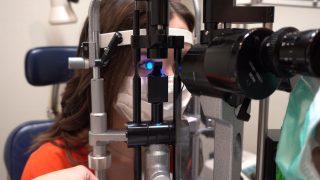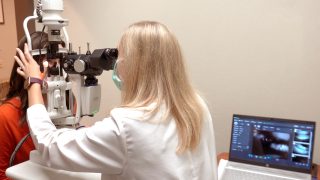People suffering from dry eye can experience a few or many of the following symptoms: It may be surprising but another common symptom of having dry eyes is the constant watering of your eyes. Your body’s natural response to low tear production or low-quality tears is to increase tear production.
We have several ways to identify the root cause of your dry eye. We will first have you fill out a questionnaire to understand the symptoms you are experiencing as well as the steps you’ve taken to treat the symptoms. We will perform a corneal topography scan to study the surface of your eye. This technology gives us a sense of the overall smoothness of the ocular surface by reflecting light off the cornea and back into a camera. A special infrared imaging device may be used to view how well your meibomian glands are functioning. Studies have shown that 70-80% of patients suffering from dry eye symptoms have “evaporative tear loss.” The meibomian glands are responsible for producing the oil layer of the tear film to prevent the tears from evaporating too quickly. Blocked glands will produce tears that have inadequate amounts of oil which leads to quickly evaporating tears. Meibomian gland dysfunction (MGD) is one of the most common causes of dry eye. Depending on our findings, your dry eye condition will be placed into one of three categories of severity.
If you’re in Category 1, we will typically recommend a warm compress placed over the eyes twice a day to help clear up the blockage in the meibomian glands. We might also prescribe artificial tears to help provide lubrication for the eyes.
If you’re in Category 2, your dry eye might be caused by inflammation. In this case, we would recommend prescription medication eye drops such as Xiidra, Restasis or Cequa. These drops work to break the inflammatory cycle by influencing the immune system.
If the diagnosis for your dry eye is evaporative tear loss, we might recommend Intense Pulsed Light (IPL) therapy to treat the obstructed meibomian glands. This technology uses quick bursts of light to change blood vessels near the surface of the skin around the eyes. IPL therapy has been shown to reduce the blockage and helps the eyes produce a better quality tear film.
If you’re in Category 3, aggressive management is required as the integrity of the eye itself is at risk. An amniotic membrane may be placed on the eye as it is packed with anti-inflammatory, anti-scarring, and pro-growth to jump-start the healing process. We may prescribe serum tears which are specialty tears developed from the patient’s blood. The patient reports to a lab, has their blood processed and then mixed with the typical components of artificial tears. Interestingly, our blood is enriched with many anti-inflammatory growth factors that help restore the normal functioning of the ocular surface.
I think I have dry eye, what are my treatment options?
 At Price Vision Group, we have a comprehensive list of treatment options for dry eye (ocular surface disorder) depending on the level of severity. The first step is to identify the symptoms of dry eye.
At Price Vision Group, we have a comprehensive list of treatment options for dry eye (ocular surface disorder) depending on the level of severity. The first step is to identify the symptoms of dry eye.What are the symptoms of dry eye?
I have several of the symptoms described, what’s the cause of my dry eye?
 An analysis will be performed to assess the stability of your tear film. During this test, a dark orange dye called fluorescein is placed onto the surface of your eye. Your doctor will view your eye using a special light to monitor how quickly your tears evaporate.
An analysis will be performed to assess the stability of your tear film. During this test, a dark orange dye called fluorescein is placed onto the surface of your eye. Your doctor will view your eye using a special light to monitor how quickly your tears evaporate.
Category 1


Category 2


Category 3
Price Vision Group BlogTHE LATEST NEWS FROM PRICE VISION GROUP

